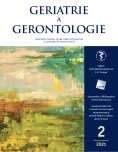Implementation of palliative care at geriatric patients with hearth failure
Authors:
Petr Coufal
Authors‘ workplace:
Kardiologické oddělení, Interní klinika, Nemocnice Pardubického kraje, a. s.
Published in:
Geriatrie a Gerontologie 2021, 10, č. 2: 62-67
Category:
Original Article
Overview
Heart failure, whether acute or chronic, is the most common clinical syndrome in cardiology, affecting not only quality but also life expectancy. The progressive development of diagnostic and therapeutic procedures in cardiology enables the treatment of the most serious conditions, on the other hand, the individual approach to the patient, his wishes and needs is disappearing. These shortcomings of “modern cardiology” make it possible to eliminate the early integration of palliative care into conventional cardiac treatment, and its importance grows especially in the final stages of human life and extends beyond its scope and supports entire families, including future survivors.
This article contains recommended tools for finding suitable palliative care responders and summarizes the reasons for introducing palliative care in the PKN cardiology department based on real data from 2019, whose retrospective analysis describes the demographic profile of patients, length of hospitalization, number of rehospitalizations until death and offers simple mortality. analysis, including analysis of the number of deaths in individual units (acute bed vs. intensive bed) as a potential site for consular palliative intervention. Considerable efforts have also been made to identify respondents to conciliatory palliative care, to improve the prognosis of this incurable disease and to refine the selection of patients benefiting from home hospice care.
Keywords:
changes in age – palliative care in cardiology – palliative care respondents identification – palliative care integration – palliative care consulta-tion team – hospice care – Quality of care
Sources
- Weber P, Meluzínová H, Kubešová H, Polcarová V. Hypertenze a stárnoucí srdce z pohledu geriatra. Kardiol Rev Int Med 2005; 7(3): 160–164.
- Aktuální populační vývoj v kostce. Český statický úřad. Dostupné z: www.czso.cz/csu/czso/aktualni-populacni-vyvoj-v-kostce.
- Souhrn Doporučených postupů ESC pro diagnostiku a léčbu akutního a chronického srdečního selhání z roku 2016. Dostupné z: www.kardio-cz.
- Proměny věkového složení obyvatelstva. Věková struktura ČR s výhledem do roku 2050. Český statistický úřad. Dostupné z: www.czso.cz.
- Městnavé srdeční selhání. Česká společnost klinické biochemie. Dostupné z: www.labtestsonline.cz/mestnave-srdecni-selhani.html.
- Clark D, Armstrong M, Allan A, et al. Imminence of death among hospital inpatients. Prevalent cohort study. Palliat Med 2014; 28 : 474–479.
- Kavalieratos D, Gelfman LP, Tycon LE, et al. Integration of palliative care in heart failure. Rationale, evidence, and future priorities HHS Public Access. J Am Coll Cardiol 2017; 70 : 1919–1930.
- Hershberger RE, Nauman D, Walker TL, et al. Care processes and clinical outcomes of continuous outpatient support with inotropes (COSI) in patients with refractory endstage heart failure. J Card Fail 2003; 9 : 180–187.
- Gřiva M, Kabelka L, Vitovec J. Odborné stanovisko: Paliativní péče u pacientů žijících se srdečním selháním. 2019.
- Sullivan MF, Kirkpatrick JN. Palliative cardiovascular care: The right patient at the right time. Clin Cardiol 2020; 43 : 205–212.
- Vítovec J, Špinarová L, Špinar J. Chronické srdeční selhání a paliativní péče. Kardiol Rev Int Med 2018; 20(1): 29–32.
- Mentz RJ, Tulsky JA, Granger BB, et al. The palliative care in heart failure trial: Rationale and design. Am Heart J 2014; 168 : 645–651.
- Kabelka L. Geriatrická paliativní péče a komunikace o nemoci. Druhé, přepracované a doplněné vydání. Praha: Mladá fronta 2018.
- McCarthy M, Addington Hall J, Ley M. Communication and choice in dying from heart disease. J R Soc Med 1997; 90 : 128–131.
- Salah K, Stienen S, Pinto YM, et al. Prognosis and NT-proBNP in heart failure patients with preserved versus reduced ejection fraction. Heart 2019.
- Vojáček J, Kettner J. Klinická kardiologie. Praha: Maxdorf 2017.
- Pocock SJ, Wang D, Pfeffer MA, et al. Predictors of mortality and morbidity in patients with chronic heart failure. Eur Heart J 2006; 27 : 65–75.
- York MK, Gupta DK, Reynolds CF, et al. B-type natriuretic peptide levels and mortality in patients with and without heart failure. J Am Coll Cardiol 2018; 71 : 2079–2088.
- W. Jiang, J. Alexander, E. Christopher, et al. Relationship of depression to increased risk of mortality and rehospitalization in patients with congestive heart failure, Arch. Intern. Med. 161 (2001) 1849–1856.
- Ng AYM, Wong FKY, Lee PH. Effects of a transitional palliative care model on patients with end-stage heart failure. Study protocol for a randomized controlled trial. Trials 2016; 17.
- Kavalieratos D, Gelfman LP, Tycon LE, et al. Palliative Care in Heart Failure: Rationale, Evidence, and Future Priorities. J Am Coll Cardiol 2017; 70 : 1919–1930.
Labels
Geriatrics General practitioner for adults Orthopaedic prostheticsArticle was published in
Geriatrics and Gerontology

2021 Issue 2
Most read in this issue
- Voice disorder as a symptom of amyotrophic lateral sclerosis
- A serious diagnosis in geriatric patient – metformin-associated lactic acidosis. Do we consider it sufficiently?
- Drugs as a significant risk factor for falls in geriatric patients
- Age-related macular degeneration
